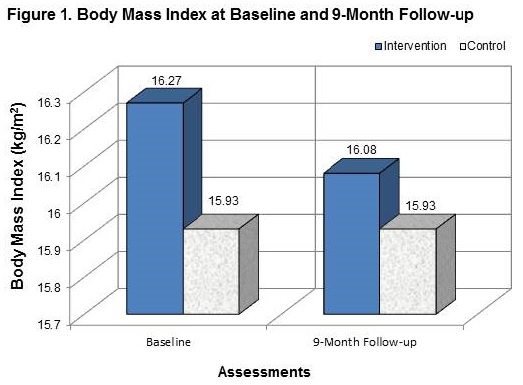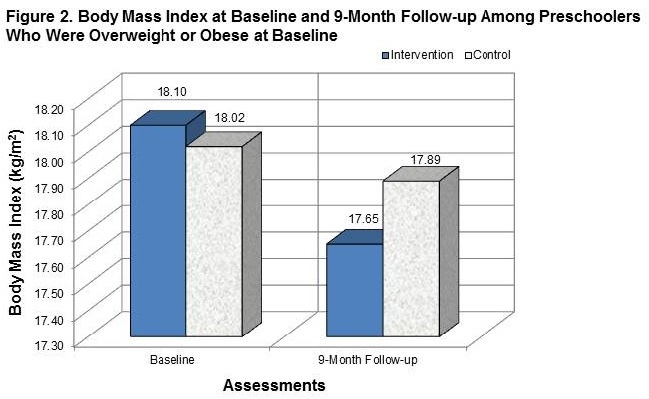Program Synopsis
Designed to increase physical activity to prevent and reduce obesity among preschool children, this intervention consists of structured physical activity that incorporates gross motor skills (e.g., running, jumping, hopping) with behavioral skills training on setting goals, self-monitoring, and acknowledging achievements. The study showed a decrease in body mass index (BMI).
Program Highlights
Program Materials
Preview and order the materials from the developer
Featured Profile
Learn more about this program and the developer who created it
Program Scores
The Need
According to the Centers for Disease Control and Prevention (CDC), children aged 2 years and older are classified as being overweight or obese if they have a body mass index (BMI) at or above the 85th percentile or 95th percentile, respectively, on age- and sex-adjusted growth charts. About one in eight (12%) preschoolers in the United States are classified as obese based on these growth charts. The obesity rate is much higher among minority preschool children, with about one in five (19%) African American preschoolers and about one in six (16%) Hispanic preschoolers classified as obese. Obese preschool children are more likely than their normal-weight peers to be obese later in childhood and adolescence, when obesity is associated with high cholesterol, high blood sugar, asthma, and mental health problems. Further, preschool children who are defined as overweight or obese are 5 times more likely than normal-weight children to be overweight or obese as adults, and obese adults are at increased risk for stroke and many chronic diseases, including coronary heart disease, hypertension, type 2 diabetes, and certain types of cancer. CDC stresses the need for child care providers and parents to support and encourage preschoolers to be physically active every day, while the American Academy of Pediatrics emphasizes the importance of increasing physical activity in the school setting to prevent and reduce childhood obesity.
The Program
Start For Life is a physical activity intervention designed to reduce BMI among 3-, 4-, and 5-year-old children in their final 2 years of preschool. Originally implemented in YMCA-affiliated preschool settings, the 9-month intervention consists of 30 minutes of structured physical activity on each school day within an outdoor, fenced playground or in the classroom during inclement weather. Each 30-minute session begins with a 3- to 5-minute warmup, then rotates through 12 segments of vigorous (2-minute segment), light (30-second segment), and moderate to vigorous (1-minute segment) physical activity, ending with a 3- to 4-minute cool-down period.
Start For Life incorporates primarily gross motor skills (e.g., running, jumping, hopping) with behavioral skills training. Lesson instructions for teachers specify the type of movement, action (e.g., "three repetitions of move to center three counts, move out three counts"), duration, and intensity for each exercise as well as cues to improve the performance of each exercise (e.g., "lift your knees up, way up!").
Based on social cognitive and self-efficacy theory, theoretical frameworks that emphasize feelings of mastery and increasing one's own abilities through the use of self-management and self-regulatory skills, Start For Life is designed to build mastery of age-appropriate physical activities. To increase children's sense of self-efficacy and self-regulation, teachers use theory-based cues or reminders printed on daily lesson cards to provide specific feedback on each child's performance, suggest a more challenging task, and provide encouragement (e.g., "John, you've done a great job jumping with your legs together. Now, how about trying two jumps in a row?"), as well as to provide information about the link between exercise and health (e.g., "Breathing hard is good. It means your heart and muscles are working hard.").
The behavioral skills addressed by Start For Life include long- and short-term goal setting, self-monitoring of incremental progress, and acknowledgement of physical activity achievements. Children set goals using an "achievement chart" as follows:
-- Each child selects a gross motor skill on which he or she would like to focus each week and affixes a sticker on the chart under the selected skill.
-- At the end of the week, each child reflects on his or her progress on the selected motor skill and affixes on the chart the "smiley face" sticker that best reflects his or her feeling about the skill.
-- Each child is asked to select the gross motor skill on which he or she wants to focus the next week.
In addition, after completing the session each day, each child updates a daily activity log, affixing a sticker indicating completion of the day's physical activities. Every 4 weeks, a certificate of accomplishment is used to summarize and positively reinforce each child's effort. Both the activity log and a certificate of accomplishment are sent home to parents at 4-week intervals to encourage family involvement in physical activity.
Teachers participate in required manual-based training before implementing the intervention. Monthly fidelity checks of each classroom teacher delivering the intervention are recommended using an observation form that is included with the Start For Life Training Manual.
Community Preventive Services Task Force Finding
 This program uses the following intervention approach for which the Community Preventive Services Task Force finds insufficient evidence: school-based programs (Obesity Management). Insufficient evidence means the available studies do not provide sufficient evidence to determine if the intervention is or is not effective. This does not mean that the intervention does not work. It means that additional research is needed to determine whether the intervention is effective.
This program uses the following intervention approach for which the Community Preventive Services Task Force finds insufficient evidence: school-based programs (Obesity Management). Insufficient evidence means the available studies do not provide sufficient evidence to determine if the intervention is or is not effective. This does not mean that the intervention does not work. It means that additional research is needed to determine whether the intervention is effective.Time Required
-- 4 hours of specialized, manual-driven Start For Life intervention training
-- 90 hours per preschool year to deliver the physical activity component of the intervention, based on 30 minutes daily across 5 school days per week during a 9-month preschool year
-- 15-30 hours per preschool year to deliver the behavioral skills component of the intervention, based on 5-10 minutes daily across 5 school days per week during a 9-month preschool year
--9 hours per preschool year to observe and rate the fidelity of intervention delivery and address any emerging issues, based on 60 minutes per month during a 9-month preschool year
Intended Audience
The Start For Life program targets children aged 3-, 4-, and 5- years who are in their final 2 years of preschool.
Suitable Settings
The Start For Life program was developed for use in YMCA-affiliated preschools but is appropriate for implementation with 3-, 4-, and 5-year-olds in any preschool, day care, or community center.
Required Resources
Materials required for implementation include:
-- Start For Life Training Manual
-- Start For Life PowerPoint Training slides and notes
-- Start For Life Site Observation Form
-- Daily Activity Log
For costs associated with this program, please contact: James J. Annesi. (See products page on the EBCCP website for contact information).
About the Study
A 9-month, randomized controlled trial evaluated the effects of the Start For Life intervention among 4- and 5-year-old preschoolers, targeting a reduction in BMI as the main outcome. Seventeen randomly selected classes from YMCA-affiliated preschools in the southeastern United States were randomized to either the Start For Life intervention group or the control group. Each intervention and control class consisted of 17 to 20 children who were required to have written consent for participation from a parent or legal guardian. Each participating class had one teacher and one assistant teacher, and teachers in both conditions administered 30 minutes per day of structured physical activity outdoors, or indoors during inclement weather. All teachers and assistant teachers received general guidelines for age-appropriate physical activities as part of their preschool teacher training, with intervention teachers and assistant teachers additionally receiving specialized training on the intervention. Teachers in intervention classrooms implemented Start For Life, and teachers in control classrooms used the activity plans they developed themselves.
Complete data were collected for 273 children (N=144 intervention group and 129 control group children). The study sample had a mean age of 4.4 years, a mean BMI of 16.1, and a mean age- and sex-adjusted BMI percentile of 61.5% according to CDC growth charts. Overall, 23.5% of the sample was overweight or obese at baseline (as defined by an age- and sex-adjusted BMI percentile at or above 85% for overweight and at or above 95% for obese, according to CDC growth charts). Fifty-two percent of the preschoolers were boys, 100% were African American, and 100% came from families with an annual income at or below 130% of the U.S. poverty line for 2011-2012.
BMI (weight in kilograms by height in meters squared) was measured by a single data collector using a portable digital Seca 876 Flat Hospital Scale with a battery power supply that was calibrated daily and after use in each classroom and a Seca 213 Portable Stadiometer with a movable head plate and vertical backboard that attached to a large floor plate for stability. Weight measurements were made to the nearest 10th of a kilogram, and height measurements were made to the nearest 10th of a centimeter. All children were able to stand unassisted.
Physical activity intensity was a measure derived from accelerometers (ActiGraph GT3X) attached at the waist of each child for 285 minutes on each of 3 measurement school days spaced evenly across the 9-month study, with the first measurement day occurring just after the start of the study. The raw accelerometer movement count data from each measurement school day were converted using the ActiGraph software to metabolic equivalents (METs) to define each child's time being sedentary (1 MET), doing moderate to vigorous physical activity (≥3 METs), and doing vigorous physical activity (6 METs). The percentage of class time spent at each of the three physical activity intensity levels was calculated for each child and then summed across the 3 measurement days.
There were no significant baseline differences between groups on demographic or BMI-related characteristics.
Key Findings

- From baseline to 9-month follow-up, intervention group preschoolers had a decrease in BMI (from 16.27 to 16.08) while control group preschoolers had no change in BMI (15.93 at both assessments, p=.035).

- Among preschoolers who were overweight or obese at baseline, with a BMI at or above the 85th percentile (37 intervention group and 28 control group preschoolers), intervention group preschoolers had a larger decrease in BMI (from 18.10 to 17.65) than control group preschoolers (from 18.02 to 17.89) from baseline to 9-month follow-up (p<.001).
Additional Findings
- Across the 9-month follow-up period, intervention group preschoolers spent a larger percentage of class time than control group preschoolers in vigorous (17.9% vs. 15.8%, p<.001) and moderate to vigorous (35.3% vs. 33.3%, p=.031) physical activity.


